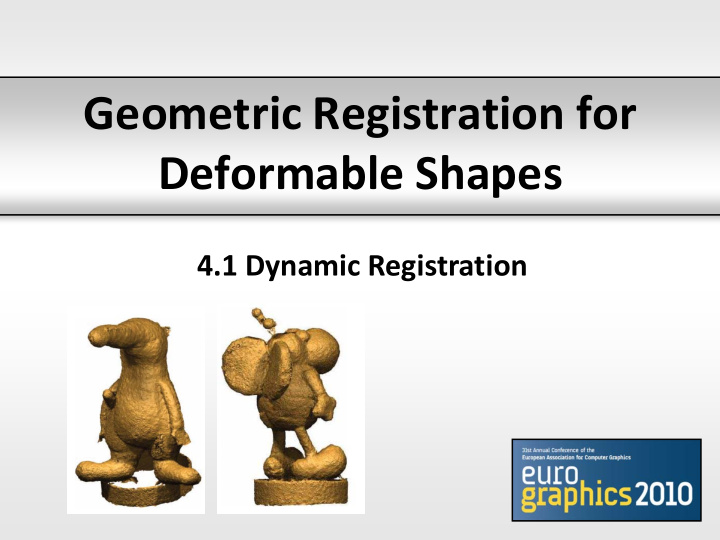



Geometric Registration for Deformable Shapes 4.1 Dynamic Registration
Scan Registration Eurographics 2010 Course – Geometric Registration for Deformable Shapes
Scan Registration Solve for inter-frame motion: Eurographics 2010 Course – Geometric Registration for Deformable Shapes
Scan Registration Solve for inter-frame motion: Eurographics 2010 Course – Geometric Registration for Deformable Shapes
The Setup Given: A set of frames {P 0 , P 1 , ... P n } Goal: Recover rigid motion { α 1 , α 2 , ... α n } between adjacent frames Eurographics 2010 Course – Geometric Registration for Deformable Shapes
The Setup Smoothly varying object motion Unknown correspondence between scans Fast acquisition → motion happens between frames Eurographics 2010 Course – Geometric Registration for Deformable Shapes
Insights Rigid registration → kinematic property of space- time surface (locally exact) Registration → surface normal estimation Extension to deformable/articulated bodies Eurographics 2010 Course – Geometric Registration for Deformable Shapes
Time Ordered Scans t j t j+1 t j+2 Eurographics 2010 Course – Geometric Registration for Deformable Shapes
Space-time Surface Eurographics 2010 Course – Geometric Registration for Deformable Shapes
Space-time Surface ∆ j t → Eurographics 2010 Course – Geometric Registration for Deformable Shapes
Space-time Surface → Eurographics 2010 Course – Geometric Registration for Deformable Shapes
Spacetime Velocity Vectors Tangential point movement → velocity vectors orthogonal to surface normals Eurographics 2010 Course – Geometric Registration for Deformable Shapes
Spacetime Velocity Vectors Tangential point movement → velocity vectors orthogonal to surface normals j j ~ ~ = ( ). ( ) 0 v p n p i i Eurographics 2010 Course – Geometric Registration for Deformable Shapes
Final Steps (rigid) velocity vectors → Eurographics 2010 Course – Geometric Registration for Deformable Shapes
Final Steps (rigid) velocity vectors ! Eurographics 2010 Course – Geometric Registration for Deformable Shapes
Registration Algorithm 1. Compute time coordinate spacing ( σ ), and form space-time surface. 2. Compute space time neighborhood using ANN, and locally estimate space-time surface normals. 3. Solve linear system to estimate (c j ,c j ). 4. Convert velocity vectors to rotation matrix + translation vector using Plücker coordinates and quarternions. Eurographics 2010 Course – Geometric Registration for Deformable Shapes
Normal Estimation: PCA Based Plane fitting using PCA using chosen neighborhood points. Eurographics 2010 Course – Geometric Registration for Deformable Shapes
Normal Estimation: Iterative Refinement Update neighborhood with current velocity estimate. Eurographics 2010 Course – Geometric Registration for Deformable Shapes
Normal Refinement: Effect of Noise Stable, but more expensive. Eurographics 2010 Course – Geometric Registration for Deformable Shapes
Normal Estimation: Local Triangulation Perform local surface triangulation (tetrahedralization). Eurographics 2010 Course – Geometric Registration for Deformable Shapes
Normal Estimation Stable, but more expensive. Eurographics 2010 Course – Geometric Registration for Deformable Shapes
Comparison with ICP ICP point-plane Dynamic registration Eurographics 2010 Course – Geometric Registration for Deformable Shapes
Rigid: Bee Sequence (2,200 frames) Eurographics 2010 Course – Geometric Registration for Deformable Shapes
Rigid: Coati Sequence (2,200 frames) Eurographics 2010 Course – Geometric Registration for Deformable Shapes
Handling Large Number of Frames Eurographics 2010 Course – Geometric Registration for Deformable Shapes
Rigid/Deformable: Teapot Sequence (2,200 frames) Eurographics 2010 Course – Geometric Registration for Deformable Shapes
Deformable Bodies Cluster points, and solve smaller systems. Propagate solutions with regularization. Eurographics 2010 Course – Geometric Registration for Deformable Shapes
Deformable: Hand (100 frames) Eurographics 2010 Course – Geometric Registration for Deformable Shapes
Deformable: Hand (100 frames) scan #1 : scan #50 scan #1 : scan #100 Eurographics 2010 Course – Geometric Registration for Deformable Shapes
Deformation + scanner motion: Skeleton (100 frames) Eurographics 2010 Course – Geometric Registration for Deformable Shapes
Deformation + scanner motion: Skeleton (100 frames) scan #1 : scan #50 scan #1 : scan #100 Eurographics 2010 Course – Geometric Registration for Deformable Shapes
Deformation + scanner motion: Skeleton (100 frames) rigid components Eurographics 2010 Course – Geometric Registration for Deformable Shapes
Performance (on 2.4GHz Athlon Dual Core, 2GB RAM) Eurographics 2010 Course – Geometric Registration for Deformable Shapes
Conclusion Simple algorithm using kinematic properties of space-time surface. Easy modification for deformable bodies. Suitable for use with fast scanners. Eurographics 2010 Course – Geometric Registration for Deformable Shapes
Limitations Need more scans, dense scans, … Sampling condition → time and space Eurographics 2010 Course – Geometric Registration for Deformable Shapes
thank you Eurographics 2010 Course – Geometric Registration for Deformable Shapes
Recommend
More recommend